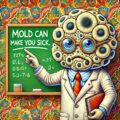11 Tips for Mold Hypersensitivity Syndrome
 If there is anyone that knows about mold hypersensitivity, it’s me. Not only did I experience it myself, but it made my daughter “disabled.” Then, after eliminating exposure and following my mold illness recovery protocol, she went from disabled to symptom-free.
If there is anyone that knows about mold hypersensitivity, it’s me. Not only did I experience it myself, but it made my daughter “disabled.” Then, after eliminating exposure and following my mold illness recovery protocol, she went from disabled to symptom-free.
In this article, I will cover 11 important tips for living with mold hypersensitivity syndrome. Afterward, I will cover common questions about mold hypersensitivity. With this information, hopefully, you will be able to live a happy and symptom-free life. Scroll down to get started.
Tips for Mold Hypersensitivity Syndrome
Find Your Safe Space
You must find a place where you are symptom-free. This is why it is so important to make changes from all angles simultaneously. If you are doing your best with your diet, you can FINALLY see how much your environment affects you. If you’ve done EVERYTHING you can with your diet, and you are still showing symptoms, then it’s time to relocate and look for your “safe place”.
To find your safe place, you need to test the environment first. To measure it, you should consider using an ERMI or EMMA test. Both of these are very helpful for identifying if there is a mold issue in the place you are living in. I prefer the EMMA test because it also tests for the mycotoxins, which are the actual things that make you sick. I have seen houses test negative for mold spores but positive for mycotoxins.
Regardless, you need to have some strategy in place to determine where your safe place will be. Once you find a place with ideal test results, go for it! From there, you can heal and overcome this illness once and for all.
Spend More Time Outdoors
Your absolute safe space is outdoors. Though there is mold outdoors, it will never accumulate to the amount that would cause you problems. In addition, the mycotoxins can’t saturate the air enough to provoke symptoms. Spend time outdoors any chance you can. This was critical for my daughter and I when we were recovering from our mold exposure.
In the end, you feel better when you are outside. It may take a little getting used to, but try to add it to your routine as much as possible. Remember, you have an environmental illness, so you can’t slack on this part of your recovery. Find any reason possible to go outside and enjoy nature. Your immune system and your higher self will thank you.
Increase Air Quality Indoors
If you have mold hypersensitivity, you have to be a nutcase about indoor air quality. At one point, my daughter was so sick that I was forced to live in a hotel for several months because I was too scared to sign a lease anywhere. When I was living there, we four air cleaners, and two box fans blowing air out the window 24/7. In addition, I cleaned the floors with vinegar once a week.
Though this may have been a bit overboard, it helped her become symptom-free in a place with mold. What I learned was, as long as you don’t allow the spores or mycotoxins to accumulate by forcing air out the window, you can improve your symptoms. Nonetheless, if you plan to live somewhere for an extended period, you should get an ERMI or EMMA test. This will tell you what the real air quality is like without all the ventilation schemes in place.
Eat Organic Plant-Based Foods
Ideally, you want to eat mostly plants and minimal animal products. If possible, your diet should be organic, high in fiber, moderate in carbohydrates and fat, and low in protein. This is the best approach for your gut health, detoxification system, and mast cells.
To maximize your potential, you want to eat 20 to 30 different plants per week. This variance in plant fiber will feed different beneficial bacteria in your gut. Ultimately, the more diverse your good bacteria are, the healthier you will be. To review some hypoallergenic plant-based recipes, click on breakfast, lunch, and dinner. Between these three links, you have hundreds of options.
Restore Your Gut Health
If you want to overcome your mold hypersensitivity, your gut health must be stable. In most cases, this is why the sensitivity developed in the first place. If your gut health was excellent, you probably would have noticed less symptoms. To restabilize your gut microbiome, you must use prebiotics and probiotics.
My favorite probiotics are raw colostrum and Probiota Bifido (Bifidobacterium) by Seeking Health. In terms of prebiotics, my favorites are acacia, inulin, arabinogalactan, and apple pectin. If you combine these with a diet based primarily on plants, your gut will be very happy, which will translate into less severe reactions when you encounter mold.
Take Mycotoxin Binders
If you have been recently exposed to mold, it is important to take mycotoxin binders. If you don’t, you could still have dysfunction in the body due to their presence. My favorite mycotoxin binders are carbonized bamboo, bentonite clay, micronized zeolite, apple pectin, acacia, colostrum, and Bifidobacterium.
If you are considering mycotoxin binders, then it’s important to know how to take them. None of these should be taken every day. In contrast, they should all be utilized in a rotation. To learn more about this, read my mold, illness recovery protocol. it will cover everything you need to know about using the supplements and everything else that’s needed for healing from mold illness.
Implement Brain Retraining
Brain retraining can help you tolerate mycotoxins better, but it’s not a solution on its own. Some examples are DNRS and slow deep breathing. My favorite is utilizing a slow deep breathing technique that adds visualization and healing frequencies. This has been absolutely life-changing for me.
Brain retraining is best after you have completely eliminated exposure. If you are trying to rewire your brain while you are still living in mold, good luck! Every time you inhale, you could be triggering neurological inflammation.
Focus on your environment, diet, and stress triggers. Once you have become successful in these areas, then start retraining your brain. This is how you can create lasting results.
Eat More Fiber/Less Protein
Increasing your fiber intake is critical because it feeds the good bacteria in your gut. In addition, when the good bacteria ferment these fibers, they produce short-chain fatty acids, which calm the immune system down. The most well-known of these is butyrate, which causes the number of regulatory T cells to increase. These are critical to reducing the severity of your environmental sensitivities.
In addition, fiber is helpful because it sweeps up toxins in the gut. This keeps the immune system calm and takes the stress off the detoxification channels. While increasing fiber, make sure to reduce animal products. These foods are detrimental to gut health when you have mold toxicity. The reason is, mycotoxins impair your breakdown of proteins/fats. The last thing you want is undigested food to rot in your stomach. This will cause a significant aggravation to your immune system, gut, and liver.
Eliminate Synthetics from Life
If you have mold hypersensitivity, I would eliminate anything synthetic from your household/regimen. This includes cleaning chemicals, personal care products, synthetic vitamins, fragrances, and other xenobiotics. If it wasn’t made from a plant, then get rid of it. I know it sounds tough, but trust me, there are plant-based options for everything nowadays.
This approach is important because if you have mold hypersensitivity, you typically have a detoxification impairment. The last thing you want to do is expose yourself to synthetic chemicals. Exposure will further compromise your detoxification system and aggravate your immune system, causing your mold hypersensitivity to worsen.
Create Dietary/Symptom Journal
It is critical to log everything you are eating and any symptom flare-ups you experience. In many cases, there are foods that aggravate people’s symptoms. For example, if you are someone with mold toxicity, animal products are not a good fit. The reason is mycotoxin poisoning impairs protein digestion. When the person then eats protein, it goes undigested and causes leaky gut to occur. This then leads them to think that the foods they eat besides the meat are the real problem when it’s not.
In addition to the food, you must pay attention to your environmental and stress triggers. Anytime you start to feel worse, it is important to document it. You can then reflect on it one time per week and connect the dots. This is the key to overcoming your symptom flares.
For example, you may go off to work and feel some symptom relief during the day, then return home, and two hours later, you start to notice your symptoms getting worse. This would be a sign that the environment was triggering you. Another example would be if you wake up in the morning with symptoms. This would possibly indicate something was in your bedroom.
To win the battle, it is crucial to document all these symptom shifts so you can identify the actual cause. This is how I help people overcome chronic illnesses when they have tried “everything.” Learn more about symptom journaling in the link provided.
Calm Down Mast Cells/Tregs
To reduce the severity of your mold hypersensitivity, you must calm down the mast cells and regulatory T cells (Tregs). Both of these determine how you react to environmental triggers. The first step is to target the mast cells by eliminating anything in your diet or lifestyle that triggers them.
After you have identified all of the irritants in your diet, you can start using immune-modulating supplements. My favorites are prebiotics like acacia, inulin, arabinogalactan, apple pectin, and colostrum. All of these have a dual action on mast cells and regulatory T cells. If you use these supplements on a rotation, you can keep reinforcing your immune system to remain calm.
Over time, by using these supplements, the severity of your reaction would be less if exposed to mold. Despite this, it would have no bearing on if this sensitivity remained in some form. The best you can ask for is to become less sensitive to mold over time.
Key Point about Mold Hypersensitivity
Mold hypersensitivity is not something that you can get rid of overnight. In some cases, it can require months and even years to recover. As long as your body isn’t exposed to the mycotoxin it’s most sensitive to, it will eventually stop producing antibodies. How long that takes depends upon the level of exposure, damage, and duration.
You must remember that the goal is not to cure your mold hypersensitivity. The goal is just to be symptom-free and happy. Remind yourself, it is most important to focus on the things you have control over. These are what you consume, the environment you live in, and the stress in your life. If you master each of these areas, you will be free of symptoms.
FAQ- Living with Mold Hypersensitivity
How common is toxic mold in buildings?
Studies have shown that up to 85% of commercial buildings in the United States have unhealthy mold levels. If you have mold hypersensitivity, you are likely to gradually develop symptoms that resemble a chronic illness. Unfortunately, this is the story of countless people because they fail to understand mycotoxin illness. They walk around thinking they have a “disease” and take pills to mask the symptoms. All along, they were just sensitive to the mold in their homes.
Why am I reacting to chemicals/fragrances?
Typically, people react to fragrances and cleaning chemicals when they are exposed to trichothecenes. If this is occurring, you must deeply investigate the place you are living in. The best way to do this is by completing an ERMI or EMMA mold test. I personally went through this myself and saw my daughter become disabled by these mycotoxins. If you are showing these symptoms, 99% of the time, it is black mold.
Can you cure mold hypersensitivity syndrome?
If you avoid toxic mold for long enough, you may be able to eliminate your hypersensitivity. Keep in mind though, if your body became sensitive once, it can happen again. Typically, there is an inherent genetic predisposition that prevents certain people from eliminating these mycotoxins as quickly as others.
Even if you have avoided mold for a decade, you are likely to still get sick if you move into a house with black mold. How severe the illness is will depend on your current health. Remember, the goal is not to cure the hypersensitivity; it’s to be symptom-free!
Is it possible to have a mold-free home?
No, every single home will have mold in it. The goal is to have ZERO toxic mold, and low levels of naturally occurring molds. Keep in mind that mold is not the enemy. You do not want to get into a place where you fear mold itself. This can make you go crazy! The truth is, you need to find somewhere without toxic mold. This can be hard since 85% of buildings have unhealthy mold levels, but it is possible.
Are newer buildings safer for mold hypersensitivity?
Newer buildings are generally better than older ones, but it’s not always true. Even buildings that are brand new have mold. Keep in mind that it did rain when they were building it. If you are looking for a safe place to live, you must perform an EMMA or ERMI test before moving in. This will give you the reassurance you need to make the right decision. Learn more about these mold illness tests by clicking the link.
Which mycotoxins are most dangerous?
The most dangerous mycotoxin class are the trichothecenes. These are produced by black mold and cause severe immune dysfunction, leaky gut, neurological issues, chemical sensitivities, food sensitivities, and plenty more. I experienced all of these symptoms firsthand when my daughter and I were exposed to black mold. Looking back on it, it felt like we were being slowly poisoned. Wow, I am so blessed to be out of that situation.
Conclusion – Mold Hypersensitivity is Manageable
Mold hypersensitivity can be extremely difficult until you know what to do. The good news is, I have plenty of helpful information on my website. Hopefully, by reading this article and viewing some of my other literature, you will be inspired to make changes so you can start on your path to healing.
If you have any doubt that mold is causing your issues, trust me, you need to at least rule it out. I was in denial myself for several years while my daughter was suffering. Once I finally accepted the truth, she went from disabled to symptom-free within eight months. I have seen miraculous stories like this with not only her but plenty of clients. Do yourself a favor and take this VERY seriously. It could be the best decision you ever made.
If you have any questions about mold hypersensitivity or chronic illnesses, contact me. I am willing to help, and blessed to have the opportunity.
Happy healing everyone!
Matt Nedin
Certified Holistic Nutritionist
EndSickness, Founder
Phone: (734) 846-8619
Email: endsickness@gmail.com
WhatsApp/Telegram: +17348468619












